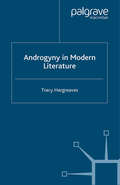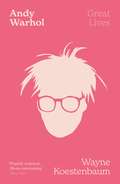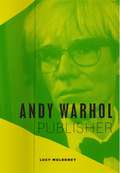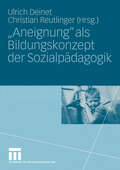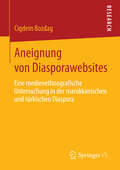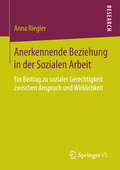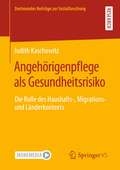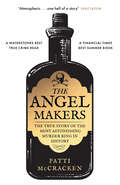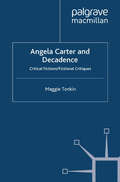- Table View
- List View
Androgyny in Modern Literature
by T. HargreavesAndrogyny in Modern Literature engages with the ways in which the trope of androgyny has shifted during the late nineteenth and twentieth-centuries. Alchemical, platonic, sexological, psychological and decadent representations of androgyny have provided writers with an icon which has been appropriated in diverse ways. This fascinating new study traces different revisions of the psycho-sexual, embodied, cultural and feminist fantasies and repudiations of this unstable but enduring trope across a broad range of writers from the fin de siècle to the present.
Andy Warhol: A Biography (LIVES #2)
by Wayne Koestenbaum'Properly analytical ... always entertaining' TIME OUT'Should tempt both those generally familiar with Andy Warhol and, even more, young people who have trouble imagining how popular art can challenge the status quo' L A TIMESPainter, filmmaker, photographer, philosopher, all-round celebrity, Andy Warhol is an outstanding cultural icon. He revolutionised art by bringing to it images from popular culture - such as the Campbell's soup can and Marilyn Monroe's face - while his studio, the Factory, where his free-spirited cast of 'superstars' mingled with the rich and famous, became the place of origin for every groundswell shaping American culture.In many ways he can be seen as the precursor to today's 'celebrity artists' such as Tracey Emin and Damian Hurst. But what of the man behind the white wig and dark glasses? Koestenbaum gives a fascinating, revealing and thought-provoking picture of pop art's greatest icon.
Andy Warhol, Publisher
by Lucy MulroneyAlthough we know him best as a visual artist and filmmaker, Andy Warhol was also a publisher. Distributing his own books and magazines, as well as contributing to those of others, Warhol found publishing to be one of his greatest pleasures, largely because of its cooperative and social nature. Journeying from the 1950s, when Warhol was starting to make his way through the New York advertising world, through the height of his career in the 1960s, to the last years of his life in the 1980s, Andy Warhol, Publisher unearths fresh archival material that reveals Warhol’s publications as complex projects involving a tantalizing cast of collaborators, shifting technologies, and a wide array of fervent readers. Lucy Mulroney shows that whether Warhol was creating children’s books, his infamous “boy book” for gay readers, writing works for established houses like Grove Press and Random House, helping found Interview magazine, or compiling a compendium of photography that he worked on to his death, he readily used the elements of publishing to further and disseminate his art. Warhol not only highlighted the impressive variety in our printed culture but also demonstrated how publishing can cement an artistic legacy.
Andy Warhol, Publisher: Author Illustrator Publisher
by Lucy MulroneyAlthough we know him best as a visual artist and filmmaker, Andy Warhol was also a publisher. Distributing his own books and magazines, as well as contributing to those of others, Warhol found publishing to be one of his greatest pleasures, largely because of its cooperative and social nature. Journeying from the 1950s, when Warhol was starting to make his way through the New York advertising world, through the height of his career in the 1960s, to the last years of his life in the 1980s, Andy Warhol, Publisher unearths fresh archival material that reveals Warhol’s publications as complex projects involving a tantalizing cast of collaborators, shifting technologies, and a wide array of fervent readers. Lucy Mulroney shows that whether Warhol was creating children’s books, his infamous “boy book” for gay readers, writing works for established houses like Grove Press and Random House, helping found Interview magazine, or compiling a compendium of photography that he worked on to his death, he readily used the elements of publishing to further and disseminate his art. Warhol not only highlighted the impressive variety in our printed culture but also demonstrated how publishing can cement an artistic legacy.
Andy Warhol, Publisher
by Lucy MulroneyAlthough we know him best as a visual artist and filmmaker, Andy Warhol was also a publisher. Distributing his own books and magazines, as well as contributing to those of others, Warhol found publishing to be one of his greatest pleasures, largely because of its cooperative and social nature. Journeying from the 1950s, when Warhol was starting to make his way through the New York advertising world, through the height of his career in the 1960s, to the last years of his life in the 1980s, Andy Warhol, Publisher unearths fresh archival material that reveals Warhol’s publications as complex projects involving a tantalizing cast of collaborators, shifting technologies, and a wide array of fervent readers. Lucy Mulroney shows that whether Warhol was creating children’s books, his infamous “boy book” for gay readers, writing works for established houses like Grove Press and Random House, helping found Interview magazine, or compiling a compendium of photography that he worked on to his death, he readily used the elements of publishing to further and disseminate his art. Warhol not only highlighted the impressive variety in our printed culture but also demonstrated how publishing can cement an artistic legacy.
Andy Warhol, Publisher: Author Illustrator Publisher
by Lucy MulroneyAlthough we know him best as a visual artist and filmmaker, Andy Warhol was also a publisher. Distributing his own books and magazines, as well as contributing to those of others, Warhol found publishing to be one of his greatest pleasures, largely because of its cooperative and social nature. Journeying from the 1950s, when Warhol was starting to make his way through the New York advertising world, through the height of his career in the 1960s, to the last years of his life in the 1980s, Andy Warhol, Publisher unearths fresh archival material that reveals Warhol’s publications as complex projects involving a tantalizing cast of collaborators, shifting technologies, and a wide array of fervent readers. Lucy Mulroney shows that whether Warhol was creating children’s books, his infamous “boy book” for gay readers, writing works for established houses like Grove Press and Random House, helping found Interview magazine, or compiling a compendium of photography that he worked on to his death, he readily used the elements of publishing to further and disseminate his art. Warhol not only highlighted the impressive variety in our printed culture but also demonstrated how publishing can cement an artistic legacy.
Anecdotal Evidence: Ecocritiqe from Hollywood to the Mass Image
by Sean CubittEcocritique is a practice of radical questioning, as essential to the critical armoury as feminism and postcolonialism have become. Like them, it extends beyond judgements about texts with clear ecological themes, demonstrating the significance of ecocriticism for any advanced understanding of cultural forms. Anecdotal method is ecocritical because it focuses on encounters, concentrated moments of crisis when social ordering and ecological forces clash. The anecdote's power to produce events, meanings and history forms a methodological entry to aesthetic politics. Anecdotal Evidence provides an outline of the need for and principles of anecdotal method; a case study of eco-critical themes in Hollywood films shaped by the Global Financial Crisis; and a confrontation with mass image databases of social and streaming media that due to their scale and organisation appear at first immune to anecdotal method. Only because the environment has a history is it possible to intervene environmentally. Because we continually misrecognise the historical production of environments, the first task of ecocritique is to bring our formative concept of ecology into crisis. Its final task will be to achieve the good life for everything connected by the historical implication of humans in ecology, and ecology in humans. No politics can be undertaken in our times except through media: ecocritical humanities have a key role in rethinking ecopolitics in the 21st century.
Anecdotal Evidence: Ecocritiqe from Hollywood to the Mass Image
by Sean CubittEcocritique is a practice of radical questioning, as essential to the critical armoury as feminism and postcolonialism have become. Like them, it extends beyond judgements about texts with clear ecological themes, demonstrating the significance of ecocriticism for any advanced understanding of cultural forms. Anecdotal method is ecocritical because it focuses on encounters, concentrated moments of crisis when social ordering and ecological forces clash. The anecdote's power to produce events, meanings and history forms a methodological entry to aesthetic politics. Anecdotal Evidence provides an outline of the need for and principles of anecdotal method; a case study of eco-critical themes in Hollywood films shaped by the Global Financial Crisis; and a confrontation with mass image databases of social and streaming media that due to their scale and organisation appear at first immune to anecdotal method. Only because the environment has a history is it possible to intervene environmentally. Because we continually misrecognise the historical production of environments, the first task of ecocritique is to bring our formative concept of ecology into crisis. Its final task will be to achieve the good life for everything connected by the historical implication of humans in ecology, and ecology in humans. No politics can be undertaken in our times except through media: ecocritical humanities have a key role in rethinking ecopolitics in the 21st century.
„Aneignung“ als Bildungskonzept der Sozialpädagogik: Beiträge zur Pädagogik des Kindes- und Jugendalters in Zeiten entgrenzter Lernorte
by Ulrich Deinet Christian ReutlingerDas Ziel des Buches ist es, das Aneignungskonzept als Bildungsbegriff der Sozialpädagogik neu zu definieren und damit eine eigenständige Position neben der Schule zu etablieren. Es bietet eine theoretische Orientierung, aber auch praxisorientierte Fokussierung der Bildungsdiskussion und formuliert auf der Grundlage des Begriffs der Aneignung als der subjektiven Erschließung von Welt einen spezifischen Bildungsbegriff der Sozialpädagogik.
Aneignung von Diasporawebsites: Eine medienethnografische Untersuchung in der marokkanischen und türkischen Diaspora
by Cigdem BozdagMigration gehört neben der Globalisierung zu den wichtigsten Faktoren, die unsere soziale Welt, Kultur und Gesellschaft verändern. Diese Veränderungsprozesse werden wiederum von Entwicklungen des Medienwandels beeinflusst. Cigdem Bozdag untersucht am Beispiel von Webseiten der marokkanischen und türkischen Diaspora, wie sich Migrationsgemeinschaften durch die neuen Medientechnologien verändern. Ihre medienethnographische Analyse basiert auf qualitativen Interviews, Beobachtungen und Inhaltsanalysen. Zunächst untersucht die Autorin Fragen zur Aneignung: Wie interpretieren,benutzen und verändern Migranten diese Webseiten? Im zweiten Schritt behandelt sie die Wahrnehmung des Herkunfts- und Migrationslandes, Fragen zur Religion und fiktive Geschichten um Themen der Vergemeinschaftung.
Aneignung von Sozial-Raum in Kleinstädten: Öffentliche Räume und informelle Treffpunkte aus der Sicht junger Menschen
by Karin WehmeyerWelche Bedeutung haben öffentliche Räume und informelle Treffpunkte in der Lebenswelt Jugendlicher? Welche Motivationen und Bedürfnisse stecken hinter der Nutzung dieser Orte? Haben (Klein-)Städte überhaupt noch die notwendigen Potenziale für das Aneignungsverhalten junger Menschen? Diese Fragen stellt die Autorin Karin Wehmeyer aktuell vor dem Hintergrund sich wandelnder Stadtstrukturen. In ihrer qualitativ angelegten Studie wird der Aneignungsprozess in öffentlichen Räumen betrachtet – fokussiert auf die Lebensphase Jugend und zusätzlich aus der Perspektive Jugendlicher. Die Ergebnisse zeigen, mit welchen unterschiedlichen Motivationen junge Menschen öffentliche Räume und informelle Treffpunkte nutzen und welche Rolle dabei das Alter sowie die Freizeitpräferenz spielen.
Anerkannter Protest?: Mediale Repräsentationen von Frauen in Ägypten in der deutschsprachigen Presse (Critical Studies in Media and Communication #23)
by Lina BrinkIn der global vernetzten Welt sind kosmopolitische Ansätze auch in der Medienkulturforschung bedeutsam: Sie eröffnen den Blick auf die Potenziale mediatisierter Anerkennung. Lina Brink zeigt, wie insbesondere feministische und postkoloniale Theorien eine machtkritische Auseinandersetzung mit solchen Ansätzen befördern und empirische Untersuchungen anleiten können. Am Beispiel der deutschsprachigen Berichterstattung zwischen 2011 und 2014 untersucht sie die mediale Repräsentation von protestierenden Frauen in Ägypten. Auf Grundlage dieser theoretisch versierten Studie entwirft sie ein Modell für eine empirische Analyse mediatisierter Anerkennung und verdeutlicht, wie eng diese mit der Etablierung hierarchisierender Deutungen verwoben sein kann.
Anerkennende Beziehung in der Sozialen Arbeit: Ein Beitrag zu sozialer Gerechtigkeit zwischen Anspruch und Wirklichkeit
by Anna RieglerIn diesem Buch wird theoretisch und empirisch herausgearbeitet, unter welchen Bedingungen in der Beziehungsgestaltung zwischen SozialarbeiterInnen und KlientInnen gesellschaftliche Verhältnisse eher verfestigt werden. Außerdem wird überprüft, unter welchen Voraussetzungen über die Beziehungsgestaltung in der Sozialen Arbeit auch verändernd auf soziale Praktiken eingewirkt werden kann. Der Fokus wird dabei auf Gerechtigkeit im Sinne befähigender Bedingungen und Prozesse, auf Anerkennung und Subjektwerdung gerichtet. Auf dieser Basis werden Ansprüche an eine anerkennende Beziehungsgestaltung in der Sozialen Arbeit formuliert und deren Bedeutung für die soziale Gerechtigkeit herausgearbeitet.
Anerkennung und Gewalt an Schulen: Eine evidenzbasierte und theoriegeleitete Interventionsstudie im Praxistest
by Tilmann KammlerWie wirken sich schulische und familiäre Anerkennungskonflikte auf das Selbstkonzept von SchülerInnen, auf deren Zugehörigkeit zu aggressiven Peergroups und auf die von ihnen gezeigte Gewalt im Schulalltag aus? Tilmann Kammler nutzt zur Klärung dieser Fragen ein umfangreiches Messinstrument, das neben Teilen aus bestehenden Studien (Forschungsgruppe Schulevaluation, PISA u. a.) auch neue Operationalisierungen zur Verfügung stellt. Neben der Befragungen von 530 SchülerInnen und der Erarbeitung von Strukturgleichungsmodellen führt der Autor eine experimentelle Intervention durch, bei der er davon ausgeht, dass von Misserfolgen und Desintegration geprägte SchülerInnen durch institutionelle und strukturelle Anerkennung ein positives Selbstkonzept entwickeln und in der Folge seltener Gewalt zeigen. Der Verlauf und die Folgen der Intervention werden durch einen Methodenmix umfassend analysiert und dokumentiert. Neben einer Überprüfung zentraler Thesen des Desintegrationsansatzes von Wilhelm Heitmeyer und der Anerkennungstheorie Axel Honneths liefert der Autor auch praktische Empfehlungen für den Schulalltag.
Anerkennung und Sichtbarkeit: Perspektiven für eine kritische Medienkulturforschung (Critical Studies in Media and Communication #18)
by Tanja Thomas Lina Brink Elke Grittmann Kaya De WolffWelches Potential liegt in einem gesellschaftstheoretisch fundierten Verständnis von »Anerkennung« und einer repräsentationskritischen Auffassung von »Sichtbarkeit« für eine kritische Medienkulturforschung? Die Autor_innen des interdisziplinär angelegten Bandes verdeutlichen mit ihren empirischen Analysen, wie Zu-Sehen-Geben in Medienkulturen mit Anerkennung, aber auch mit Missachtung, Verletzbarkeit und Kontrolle verbunden sein kann, und sie zeigen Möglichkeiten der Intervention in tradierte Normen von Anerkennung und Sichtbarkeit auf. Die Beiträge beleuchten unterschiedliche mediale Angebote und Praktiken des Medienhandelns in (digitalen) Öffentlichkeiten, u.a. in Film, Fernsehen, Fotografie, Journalismus und ›sozialen‹ Medien aus gerechtigkeitstheoretischer, postkolonialer und queer_feministischer Perspektive.
Anerkennung und Widerstand: Lokale islamische Identitätspraxis in Hamburg (Globaler lokaler Islam)
by Laura HaddadDer Topos »Islam in Europa« ist durch Dichotomisierung gekennzeichnet: Im öffentlichen und wissenschaftlichen Diskurs offenbart sich eine binäre Auseinandersetzung, die entweder muslimische Subjektivierung oder die Institutionalisierung des Islam verhandelt. Dabei werden Europa und der Islam als voneinander getrennte Einheiten konstruiert. Laura Haddads ethnographische Fallstudien zeigen hingegen einen wechselseitigen Aushandlungsprozess von Islam und Europa, der diese Dichotomien in Frage stellt. Anhand der europäischen Metropole Hamburg werden Anerkennung und Widerstand als zwar ambivalente, aber einander bedingende Konzepte sichtbar.
Anfertigung wissenschaftlicher Arbeiten: Ein prozessorientierter Leitfaden zur Erstellung von Bachelor-, Master- und Diplomarbeiten
by Alfred BrinkDieses Buch ist aus Intensivseminaren zum Anfertigen von Abschlussarbeiten entstanden, die der Autor seit fast zwei Jahrzehnten in jedem Semester an der Westfälischen Wilhelms-Universität Münster hält. Der praktische Leitfaden ist Lehrbuch und Nachschlagewerk zugleich. Der Aufbau entspricht den Arbeitsphasen einer wissenschaftlichen Arbeit und ist damit der ideale Begleiter für alle, die an einer Arbeit schreiben oder sich darauf vorbereiten. Die vorliegende fünfte Auflage wurde grundlegend überarbeitet und aktualisiert. Speziell für Abschlussarbeiten in englischer Sprache, die an deutschen Hochschulen immer häufiger verlangt werden, bietet der Autor im Online-Service zum Lehrbuch unter "Zusätzliche Information" ein ergänzendes E-Booklet zum Download auf www.springer-gabler.de an.
Anfertigung wissenschaftlicher Arbeiten: Ein prozessorientierter Leitfaden zur Erstellung von Bachelor-, Master- und Diplomarbeiten
by Alfred BrinkDieses Lehrbuch ist aus dem einwöchigen Intensivseminar "Anleitungen zum Anfertigen von Bachelor-, Master- und Diplomarbeiten" hervorgegangen, das der Autor seit über 15 Jahren in jedem Semester an der Westfälischen Wilhelms-Universität Münster veranstaltet. Der praktische Leitfaden ist Lehrbuch und Nachschlagewerk zugleich konzipiert. Dank des prozessorientierten Aufbaus in acht Lerneinheiten kann das Werk parallel zum eigenen wissenschaftlichen Arbeitsfortschritt eingesetzt werden. Für die aktuelle vierte Auflage wurden vor allem die Ausführungen zur Literaturrecherche und -beschaffung aktualisiert, da hier in den letzten Jahren und Monaten viele Neuerungen eingetreten sind. Im OnlinePLUS-Service zum Lehrbuch ergänzt ein E-Booklet die speziellen Belange, die bei einer englischsprachigen Abschlussarbeit an einer deutschen Hochschule zusätzlich zu berücksichtigen sind.
Angehörigenpflege als Gesundheitsrisiko: Die Rolle des Haushalts-, Migrations- und Länderkontexts (Dortmunder Beiträge zur Sozialforschung)
by Judith KaschowitzDie Versorgung pflegebedürftiger Angehöriger ist eine der wichtigsten Aufgaben unserer Zeit. Unklar ist, ob damit Gesundheitsverschlechterungen für informell Pflegende verbunden sind. Diese Arbeit geht unter Zuhilfenahme europäischer Längsschnittdaten (Survey of Health, Ageing and Retirement in Europe und English Longitudinal Study of Ageing) der Frage nach, ob informelle Pflege mit negativen Gesundheitsfolgen verbunden ist. Dabei wird berücksichtigt, dass mögliche Gesundheitsfolgen in Abhängigkeit des Ortes (innerhalb oder außerhalb des eigenen Haushalts) und Landes der Pflegeübernahme sowie der Herkunft der Pflegenden variieren können. Im Ergebnis zeigt sich, dass Pflegekonstellationen mit einer großen (emotionalen/räumlichen) Nähe zwischen Pflegenden und Gepflegten sowie in Ländern mit geringem formellen Pflegeangebot besonders belastend sind. Keine Unterschiede in den Gesundheitsfolgen von informeller Pflege zeigen sich dagegen in Abhängigkeit des Herkunftskontexts, sprich Migrationshintergrundes. Die Ergebnisse machen sozialpolitischen Handlungsbedarf bei der Unterstützung Pflegender deutlich und zeigen auf, dass Wohlfahrtsstaaten Rahmenbedingungen schaffen sollten, gesundheitsschonende Angehörigenpflege zu ermöglichen.Die AutorinJudith Kaschowitz ist als Post-Doktorandin an der TU Dortmund am Lehrstuhl für Sozialstruktur und Soziologie alternder Gesellschaften tätig. Sie forscht empirisch quantitativ und international vergleichend zu Fragestellungen im Bereich der Alterns- und Gesundheitssoziologie.
Angel Face: The Making of a Criminal (Routledge Revivals)
by Walter ProbynFirst published in 1977, Angel Face documents the penal life of Walter Probyn, who spent 30 out of 44 years in prison and escaped 15 times. He describes the succession of events which began when he was a nine-year-old ‘blitz kid’ who ‘stole’ a can of peas from a bombed shop, and tells in absorbing and harrowing detail his time in prison and on the run. Important though his description and indictment of prison life and the treatment of so-called hardened offenders may be, his particular attention to carefully planned and ingenious escapes gives great insight into his fight for retaining his independence and his insatiable craving for freedom. This is not a book which glamourises crime. It does raise serious and debatable questions about the need for reform of a penal system which has failed in its objectives. These questions are discussed in an introduction and final commentary by noted criminologist, Stan Cohen, who puts Probyn’s story into a wider context. His life is a classic example of the way in which the penal system, far from curing crime, may actually encourage it, by strengthening the resolve and bitterness of those who resist being institutionalised and fitting into authority’s moulds. But is three-quarters of a lifetime a responsible price to pay? The authorities and Walter Probyn give different answers. This book will be of interest to anyone intrigued by the other side of the penal system but especially to students of law, criminology, and sociology.
Angel Face: The Making of a Criminal (Routledge Revivals)
by Walter ProbynFirst published in 1977, Angel Face documents the penal life of Walter Probyn, who spent 30 out of 44 years in prison and escaped 15 times. He describes the succession of events which began when he was a nine-year-old ‘blitz kid’ who ‘stole’ a can of peas from a bombed shop, and tells in absorbing and harrowing detail his time in prison and on the run. Important though his description and indictment of prison life and the treatment of so-called hardened offenders may be, his particular attention to carefully planned and ingenious escapes gives great insight into his fight for retaining his independence and his insatiable craving for freedom. This is not a book which glamourises crime. It does raise serious and debatable questions about the need for reform of a penal system which has failed in its objectives. These questions are discussed in an introduction and final commentary by noted criminologist, Stan Cohen, who puts Probyn’s story into a wider context. His life is a classic example of the way in which the penal system, far from curing crime, may actually encourage it, by strengthening the resolve and bitterness of those who resist being institutionalised and fitting into authority’s moulds. But is three-quarters of a lifetime a responsible price to pay? The authorities and Walter Probyn give different answers. This book will be of interest to anyone intrigued by the other side of the penal system but especially to students of law, criminology, and sociology.
The Angel Makers: The True Story of the Most Astonishing Murder Ring in History
by null Patti McCrackenA Financial Times Best Summer Book 2023 A Waterstones Best True Crime Book Nagyrev, Hungary, 1929. Over 160 mysterious deaths. A group of local wives conspiring together, and one woman at the centre of it all… In 1929, a dark secret at the heart of a Hungarian farming village was finally exposed. For more than 15 years, Nagyrev had harboured a group of serial killers, one of the largest murder rings ever recorded. They came to be known as The Angel Makers. Led by a sharp-minded midwife known as Auntie Suzy, the local wives brazenly rid themselves of unwanted relatives, spooning doses of arsenic into soup and wine, stirring it into coffee and brandy. Murder was just another chore. Over 160 mysterious deaths later, the unlikely gang of murderesses came to justice in a sensational trial reported the world over. With absorbing detail, Patti McCracken pieces together the lives of Auntie Suzy, her wide network of killers, the unsuspecting victims and the villagers who witnessed it all. The Angel Makers is the utterly gripping account of an almost unbelievable – yet entirely true – moment in crime history.
Angel of Death: The Story of Smallpox
by G. WilliamsThe story of the rise and fall of smallpox, one of the most savage killers in the history of mankind, and the only disease ever to be successfully exterminated (30 years ago next year) by a public health campaign.
Angela Carter and Decadence: Critical Fictions/Fictional Critiques
by M. TonkinBy reading key Carter texts alongside their Decadent intertexts, Tonkin interrogates the claim that Carter was in thrall to a fetishistic aesthetic antithetical to her feminism. Through historical contextualization of the woman-as-doll, muse and femme fatale, Tonkin tests Carter's own description of her fiction as a form of literary criticism.
Angelica's Book and the World of Reading in Late Renaissance Italy (Cultures of Early Modern Europe)
by Brendan Dooley Beat Kümin Brian CowanThrough the lens of a history of material culture mediated by an object, Angelica's Book and the World of Reading in Late Renaissance Italy investigates aspects of women's lives, culture, ideas and the history of the book in early modern Italy. Inside a badly damaged copy of Straparola's 16th-century work, Piacevoli Notti, acquired in a Florentine antique shop in 2010, an inscription is found, attributing ownership to a certain Angelica Baldachini. The discovery sets in motion a series of inquiries, deploying knowledge about calligraphy, orthography, linguistics, dialectology and the socio-psychology of writing, to reveal the person behind the name. Focusing as much on the possible owner as upon the thing owned, Angelica's Book examines the genesis of the Piacevoli Notti and its many editions, including the one in question. The intertwined stories of the book and its owner are set against the backdrop of a Renaissance world, still imperfectly understood, in which literature and reading were subject to regimes of control; and the new information throws aspects of this world into further relief, especially in regard to women's involvement with reading, books and knowledge. The inquiry yields unexpected insights concerning the logic of accidental discovery, the nature of evidence, and the mission of the humanities in a time of global crisis. Angelica's Book and the World of Reading in Late Renaissance Italy is a thought-provoking read for any scholar of early modern Europe and its culture.
